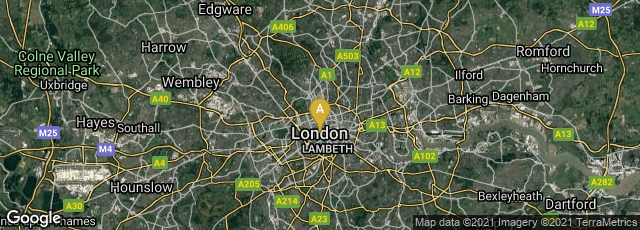

A: London, England, United Kingdom
Besides the development of the appropriate book cloth, another significant factor in the development of cloth edition bindings pointed out by Douglas Ball in his Victorian Publishers' Bindings (1985) pp. 14-15 was the development, and patenting in 1832 of the Imperial Arming Press, also called an embossing or stamping press, which allowed for quality stamping onto cloth and leather with excellent control and very high pressure.
In Bookbinding Then and Now (1959) Darley pp. 35-36 offers perspective on the significance and impact of this invention:
"The press was called an Arming Press, probably because the first use envisaged for it was embossing coats of arms on the sides of books. It was an iron printing press converted to the needs of the binding trade. No one knows who made the first of these presses. Arnett, writing in 1835, three years after the event describes the Imperial Press of Cope and Sherwin: the Judges' report of the 1851 Exhibition names Hopkinson's press--and others. No patent was involved [incorrect]: all followed the pattern of the iron printing presses developed during the eighteen-twenties, the difference being that the platen of the Arming Press was enlarged to hold a heater box, and the block worked downward from above instead of the face-up way of type in the printing press. Into the heater box went either a gas burner, or for those binderies not yet fitted with gas, two iron bars previously made red hot in the fire. The heat thus provided heated the block screwed or glued to the platen; one impression of this heated block on a case previously washed with glaire, rubbed with a greasy rag, and having gold leaf laid in place, in the time-honoured way, could cover that case with lettering and ornament in no more time than a finisher would need for impressing one tool.
"As is the way of machines, the Arming Press imposed Conditions. Before the spine of a cover could enter the narrow gap between platen and bed of the machine, the binder had to make a case separate from the book. For the first itme in the long history of binding the sacrosanct practice of lacing-on boards had to be abandoned. In 1832 no self-respecting binder would have omittted this essential process in binding unless driven to it. And when driven to it he would have held his peace about so grave a transgression.
"The changes resulting from this Arming Press, the binding trade's second machine, were great. On the one hand the making of separate cases was a simplification in the process of covering books; on the other it made available to cloth bindings something wonderfully like the elaborations that hitherto had belonged exclusively to hand-tooled leather. it also created in the trade two new classes of workers— case-makers and blockers, as well as engravers of brass blocks for the binding trade— and it enabled publishers, for the first time, to issue their publications in a style that was pleasing and acceptable as a permanent binding."
Here is a video produced by binder Trevor Lloyd showing the design and operation of a restored Imperial arming press: